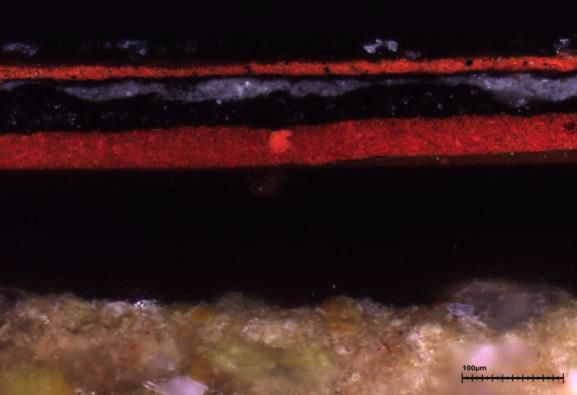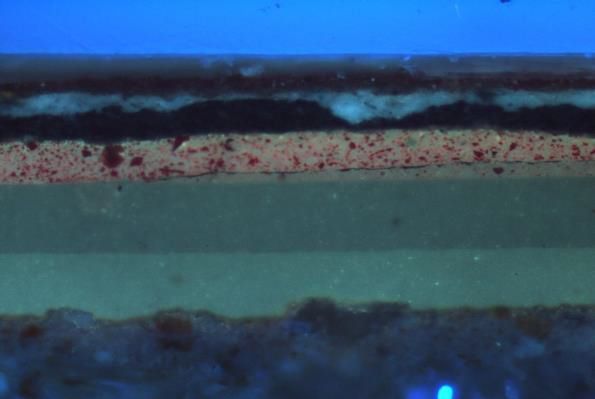The scientific analyses supporting the project, and described in the work packages below, are carried out by the Laboratory Department – Cell Paintings of KIK-IRPA and the Separation Science Group (SSG) at Ghent University, Faculty of Sciences, Department of Organic and Macromolecular Chemistry. At KIK-IRPA the emphasis of the analyses is put on the application of Thermally Assisted Hydrolysis and Methylation Pyrolysis-Gas Chromatography/ Mass spectrometry (THM-Py-GC/MS), while at UGhent complimentary state-of-the-art instrumentation in the field of separation science and mass spectrometry can be used to analyze compounds in trace concentrations.
Analyses at KIK-IRPA, as well as the entire PHySICAL project, is coordinated by Dr. Steven Saverwyns, while the scientific work at the UGhent is coordinated by Prof. Dr. Frederic Lynen. The work is conducted mainly by Jonas Veenhoven, who is carrying out his PhD in Chemistry within the project (promotors Prof. Dr. Frederic Lynen (UGhent), Prof. Dr. Ing. Maarten van Bommel (University of Amsterdam) and copromotor Dr. Steven Saverwyns (KIK-IRPA).
Work-package 2: Technical studies of RMAH objects
Sampling site
Careful examination of the sampling site on the lacquered objects to be studied is a prerequisite in order to sample intact and representative areas. In this first phase samples will be taken from areas that have through time been protected from physical and light damage. X-radiography and UV photography will preferably be used to visualize former restoration treatments that would otherwise not be visible and could have contaminated the sampling site. In order to compare lacquer that has through time been protected from visible light and UV irradiation, with naturally aged lacquer, samples will also be taken from unprotected areas.
Layer build up
Asian lacquers consist usually of a large number of (lacquer) layers applied on top of each other. Cross-sections are inevitable to study the build-up of the lacquers. A tiny piece of lacquer mounted in a synthetic resin subsequently polished to reveal the multi-layered structure, results in a cross-section. It provides information on the number, appearance and thickness of original and restoration layers present. The stratigraphic layer build-up will first be studied with optical microscopy using both visible and UV illumination.
Cross-sections of an East Asian lacquer sample at 500x magnification, left hand side under visible light and right hand side under ultraviolet illumination. Especially under UV-light the different lacquer layers become clearly visible. The difference in fluorescence behaviour points to a difference in chemical composition, and hence in lacquer composition, making layer-to-layer sampling necessary to get detailed information on the lacquer composition.
Inorganic and organic analysis
Identifying inorganic pigments in a cross-section is well established and will be performed by scanning electron microscopy with energy dispersive X-ray spectroscopy (SEM-EDX) and micro-Raman spectroscopy (MRS). To get a general idea of the organic composition of the sample and to map compositional changes between layers, cross-sections will be analyzed with (imaging) attenuated total reflection Fourier transform infrared spectroscopy (ATR-FTIR). Unfortunately, the (imaging) ATR-FTIR research on cross-sections does not allow giving detailed information on the sample composition, although differences in layer composition might become clear through detection of functional groups and their abundances. For results on the molecular level, analysis of individual layers is necessary.
East Asian lacquer is in non-degraded cured state resistant against acids, alkalis and insoluble in organic solvents, which forms an analytical challenge to analyze them towards organic composition. Analytical separation methods like liquid or gas chromatography coupled to mass spectrometry require the sample to be in solution prior to analysis. Therefore, methods capable of analyzing solid materials, and at the same time giving detailed compositional information, are required.
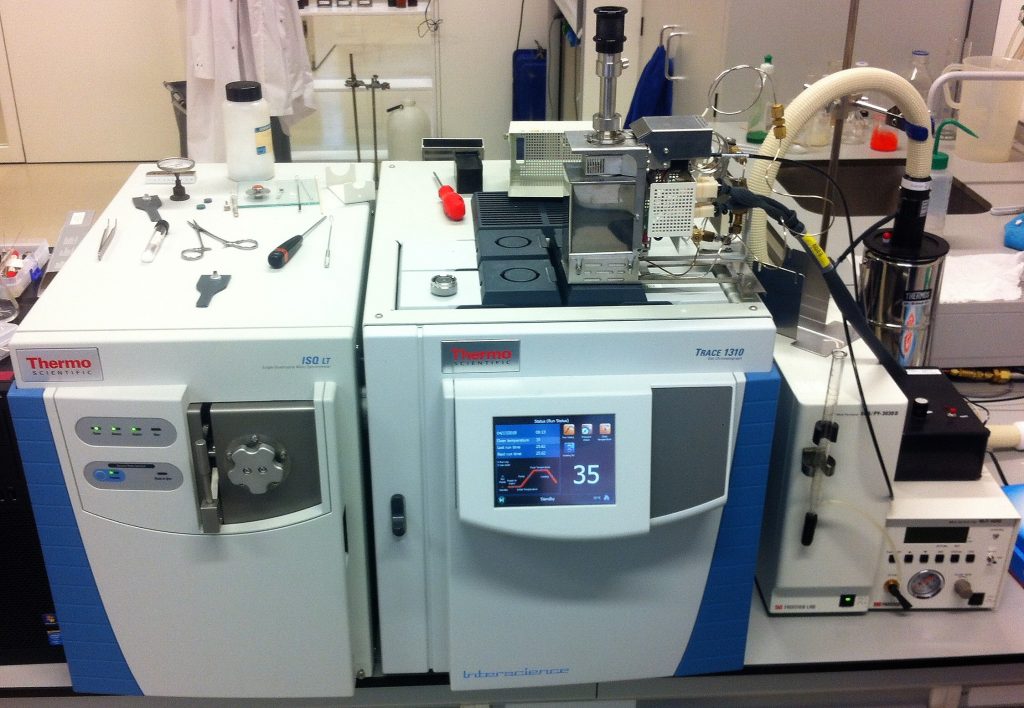
At present the best analytical technique for comprehensive characterization of organic materials in Asian lacquers is the hyphenated technique Pyrolysis-Gas Chromatography/Mass Spectrometry (Py-GC/MS). The advantage of using a coupled pyrolysis system is that it allows the introduction of solid materials by decomposition of the sample into smaller fragments by heat. In order to increase the volatility of especially polar compounds, thermally assisted hydrolysis and methylation (THM) with tetramethylammonium hydroxide (TMAH) will be used (THM-Py-GC/MS). Identification is performed by matching the unknown mass spectrum to reference spectra in a semi-automatic way using Automated Mass Spectral Deconvolution and Identification System (AMDIS) software and specific target libraries for Asian lacquer analysis developed within the RAdiCAL (Recent Advances in Characterizing Asian Lacquer) research project at the Getty Conservation Institute and the currently running BRAIN project ELinC (European Lacquer in Context). These form essential tools within the data processing and make it possible to produce identification reports on more than 1400 marker compounds of Anacard lacquers, proteins, carbohydrates, terpenoid resins, oils and other constituents in individual layers of (Asian) lacquer.
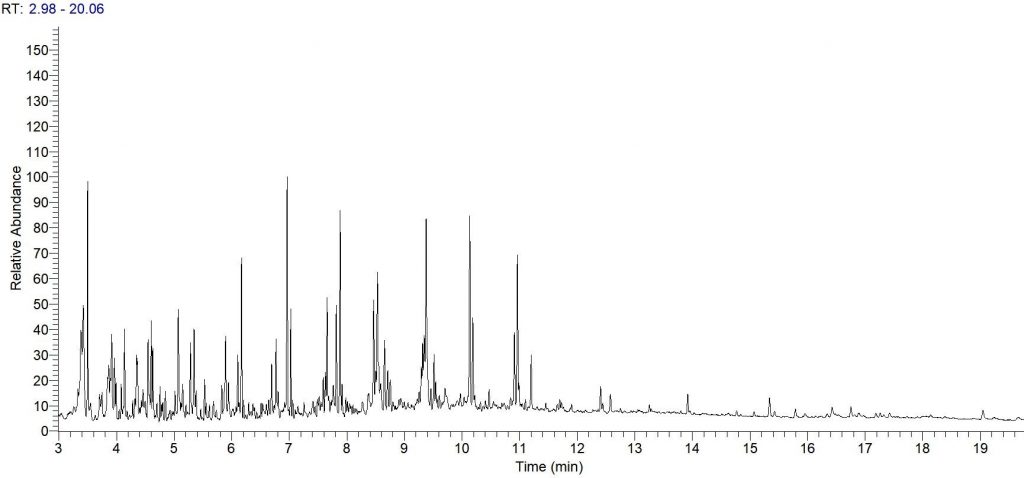
Layer sampling for organic analysis is done in situ, close to the cross-section sampling site. Sampling will be performed primarily under UV-light, as differences in organic composition are most often better visible under UV illumination. Generally, a 4mm2 surface is sufficient to yield enough sample material for THM-Py-GC/MS analysis on layers as thin as 20μm.
Work-package 3: Mock-ups and artificial aging of Asian lacquer formulations
Reproduction
The mock-up samples are subdivided by technical application. Three types of samples are distinguished: free film, single layer and full stratigraphic layer samples. The free film and single layer samples will be applied on borosilicate glass slides, using a film applicator in order to obtain an even layer thickness and homogenous surface. This is a fairly straightforward and reproducible method. The full stratigraphic layer samples will be applied by brush or spatula (depending on the layer) on a wooden core. To avoid too many variables, all ground layers will be prepared based on the same type of lacquer. The urushi samples will have an urushi ground, the laccol, a laccol ground and the thitsi, a thitsi ground. Even though this is not the case with real objects, the introduction of another material would make the analysis unnecessary difficult, as it is known that ingredients tend to migrate through different layers.
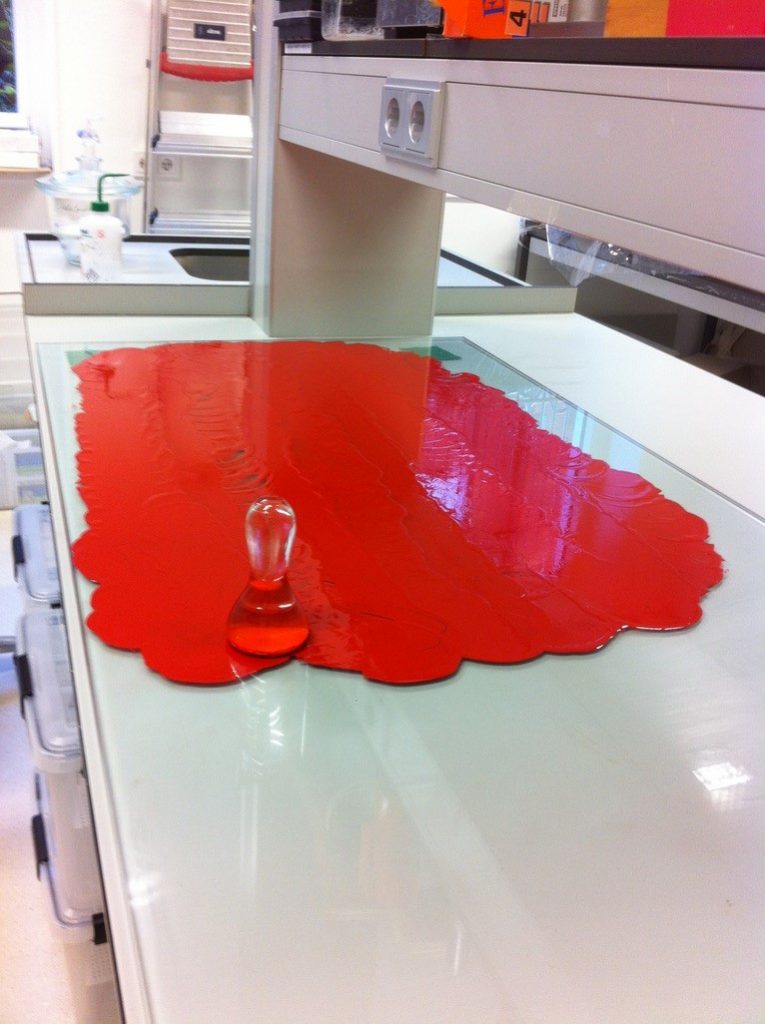
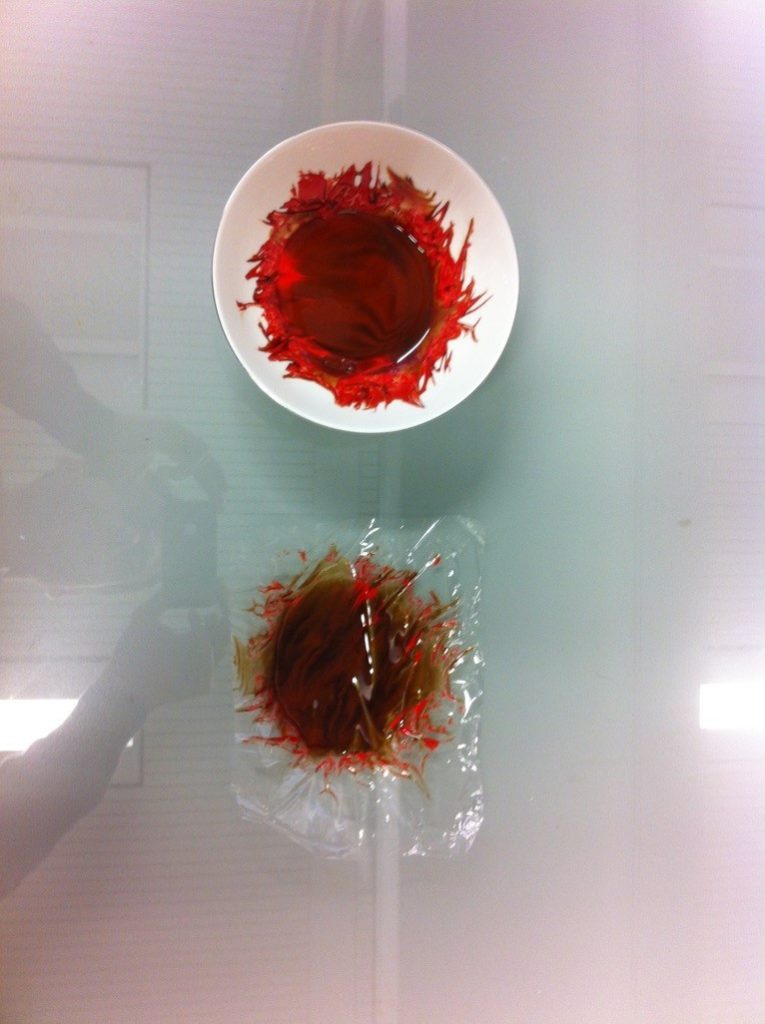
 Making red (cinnabar) lacquer for the single layer samples (on glass substrate).
Making red (cinnabar) lacquer for the single layer samples (on glass substrate).
Artificial aging
As the characteristics and the vulnerability of Asian lacquers towards solvents change upon ageing of the lacquer, all mock-up samples must be artificially aged prior to the solvent cleaning tests. This study will reproduce the aging, through the impact of light and by applying relative humidity (RH) cycles. The importance of RH after light aging is crucial in order to reproduce the micro cracking, seen on historic lacquered surfaces. The micro cracked surface could affect the choice for a cleaning treatment as solvents could penetrate through the cracks deeper into the lacquer structure and swell and leach other components from lower layers.
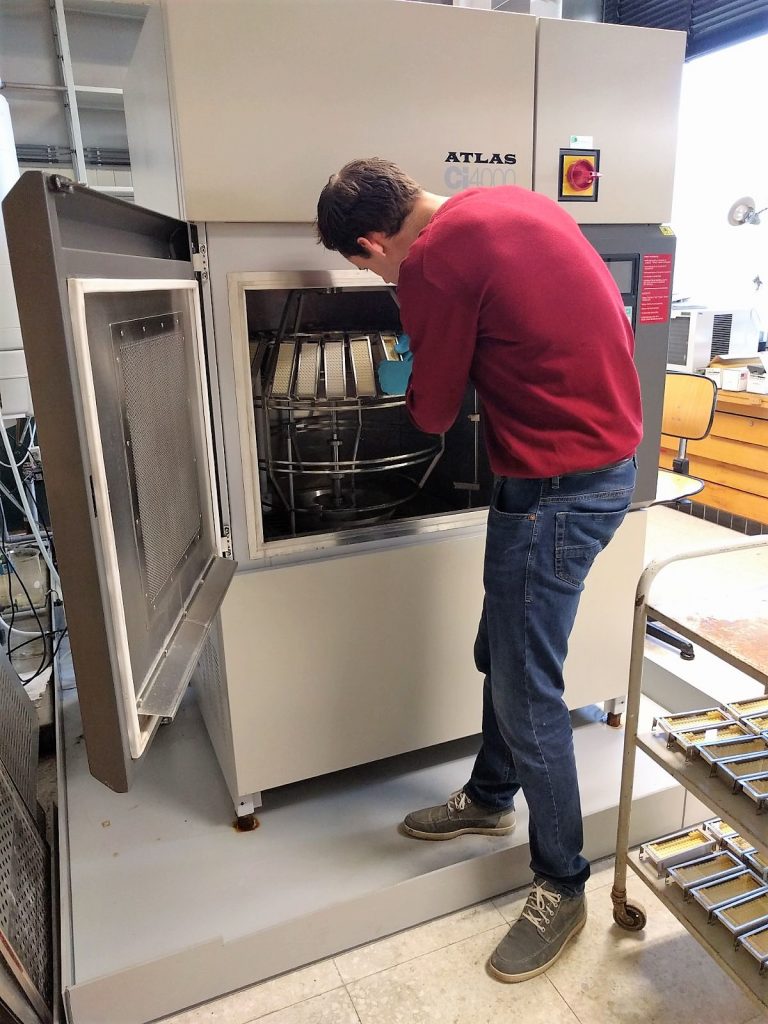
Work-package 4: Inventarisation and evaluation of cleaning procedures used in the treatment of Asian lacquer, paints and other coating materials
In conservation work, water cleaning or the use of alcohol-based solvents is common. Beside the pure solvents additional methods are used, which are solvent-based (solvent mixtures, gels, tissues etc.). Before solvents are used in the conservation of artifacts, the risks and suitability must be verified. Some layers of contamination require “stronger” solvents to dissolve and to remove the layer; however, these harsher solutions are potentially dangerous to the original material. The nowadays most used solvents associated with the cleaning of lacquer include the polar protic solvents such as methanol and water, dipolar aprotic solvents such as acetone, and the non-polar solvents such as hexane. For degraded lacquers these form a risk, especially polar solvents and water, although still used today to remove unwanted material e.g. dirt, varnishes etc. Unfortunately, also original lacquer material can be removed simultaneously. This danger is most often minimized by for example short contact-times and careful manipulation of the cleaning agent.
Evaluation based on existing literature
This part of the study aims at evaluating current cleaning treatments, which will be performed by studying conservation reports, case studies and other relevant literature. Selection on the availability of conservation reports, describing cleaning practices, is one of the criteria for implementing the historical objects in this project.
Evaluation based on interviewing conservators
Lacquer conservators will be interviewed concerning their experiences with the cleaning of lacquer. Treatments in which the cleaning was successful is important, but especially failed cleaning procedures are essential, relating to the chemical and physical implications to the lacquer surface, e.g. chemical reactions, change in color, gloss, brittleness, etc.
This should lead to a selection of solvents, which seems promising for the cleaning of Asian lacquers, and will form the basis of the solvents to be used in the further steer of the research.
Work-package 5: Study of leaching and swelling parameters of Asian lacquer formulations by using gravimetric methods
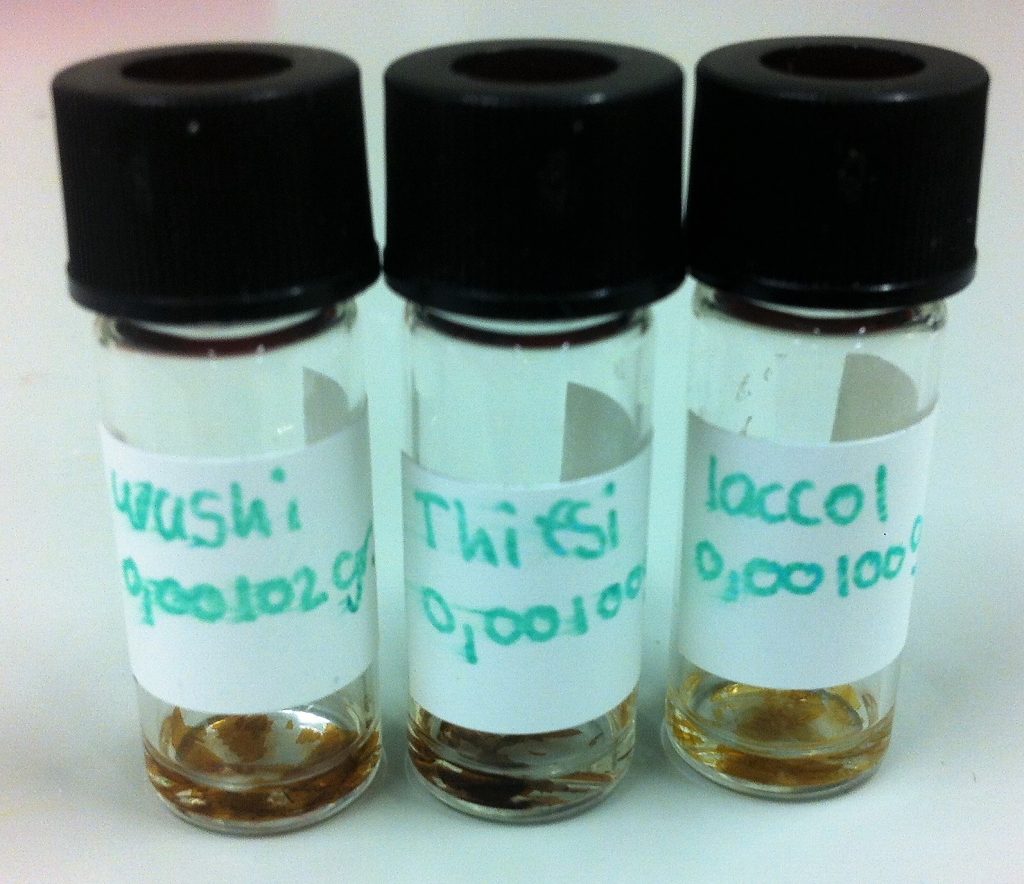
Despite the insolubility of degraded lacquer, solvents are able to permeate the lacquer causing swelling and leaching of the lacquer top surface layers, although the extend of the effect depends on the solvent type used. Swelling is a result from the absorption of solvent into the lacquer layer. This can potentially produce a softened lacquer film for which there is an enhanced risk of mechanical damage during cleaning. This phenomenon is well recognized, and to some extent it can be judged empirically by the conservator and minimized through careful manipulation of the solvents during cleaning. Leaching refers to the extraction of organic components from the solid, polymeric matrix of the lacquer film, and its potential effects are longer term and less immediately tangible to the conservator. The effects of leaching could include increased brittleness and changes in optical characteristics. A detailed understanding of these solvent effects is important to provide a theoretical base for cleaning practice, to help conservators to predict and minimize the risks inherent in solvent treatments.
Immersion studies
Free film samples will be immersed in a range of solvents and aqueous solutions in order to assess the swelling and leaching parameters gravimetrically.
Vapor sorption
The lacquer free films will be suspended in a saturated solvent atmosphere, after which time the mass increase will be determined.
Dynamic Vapor Sorption (DVS)
This method is used for improving the gravimetric analysis approach.
Work-package 6: Analysis of extractable components of Asian lacquer
The investigations on extractable compounds will be executed on laboratory prepared and artificially aged free-film, single layer (on glass substrate) and full stratigraphic layer reproductions (WP3). This will eventually generate knowledge on the effects solvents and aqueous solutions at different levels of pH and conductivity have on the lacquer surface and provide new insights into the nature of extractable compounds.
Qualitative analysis in terms of characterizing extracted components will be performed by THM-Py-GC/MS and LC/MS.
Experiments designed to investigate the potential leaching effects of realistic exposures to solvents, as in cleaning treatments, will be performed on the one layer and full stratigraphic layer samples. The following procedures will be carried out to perform the extraction.
Theoretical immersion: samples (free film) will be immersed in solvent for 24 hours. The liquid fraction will be pre-concentrated or transferred to a clean vial, and dried under a stream of nitrogen. The dried extract is to be re-dissolved or derivatized as needed for analysis.
Surface extraction: a small droplet is put on the lacquer surface (one layer and full stratigraphic layer samples) by using a micropipette. After a few minutes the micropipette is used to pull the liquid back up. Excess solvent is evaporated under a stream of nitrogen and the extract is derivatized and analyzed.
To conservation practice related extraction: the mechanical action by using a cotton swab or textile tissue soaked in solvent will be performed on the sample surface (full stratigraphic layer). This involves sampling and analysis of the surface, before and after
Development and evaluation of innovative pre-concentration methods
Stir bar sorptive extraction (SBSE) of aqueous solutions was developed at Ghent University as a tool allowing, in combination with thermal desorption GC/MS to reach ppt and even ppq level sensitivities and in effect improving lowering the reachable limits of detection of GC/MS by up to three orders of magnitude. The solventless extraction character of SBSE combined with thermal desorption thereby allows for refocusing in cryogenically cooled programmable temperature vaporization GC injectors leading to more sensitive GC/MS analyses. The concomitant potential of SBSE for direct extraction of solutes from leachable surfaces has thus far been much underexplored and has been limited to some life sciences applications (skin sampling). This harmless and non-invasive pre-concentration method will therefore for a first time be applied for the analysis of historical objects in general and for Asian lacquer in particular. LC/MS, and other separation techniques can also be combined with SBSE through liquid extraction of the stir bars. As the PDMS can also be replaced by more polar sorptive materials or pre-impregnated with various solvents prior to usage broad extractive capabilities in terms of analyte polarity can be obtained. In a proof of concept study the aged mock up samples will be extracted with SBSE before and after treatment with various solvents to assess the capability of SBSE to monitor leaching of solutes into the stir bars.

Work-package 8: Study of solvent induced reaction mechanisms
This part of the study will not only look at the qualitative identification of the extractable compounds, but also on how these molecules are formed by studying the reaction mechanisms. Only for commonly found extracted compounds elucidation of the reaction mechanism seems feasible, as this might lead to a better understanding of the solvent/lacquer interaction. Generally, solvents, which are mostly inert should not generate reactions (besides some esterification with alcohols) so the focus will be on aqueous treatments (with adjusted pH), as these may cause molecular changes. Three-dimensional NMR analysis or LC/HRToFMS (possibly with orbitrap MS) will be used to elucidate structures and to make hypothesis about reaction mechanisms leading to these products.
